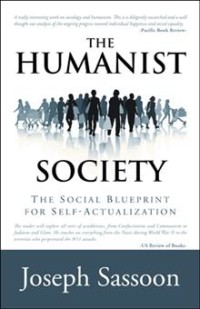Title: The Humanist Society: The Social Blueprint for Self-Actualization
Author: Joseph Sassoon
Publisher: iUniverse
ISBN: 978-1-4917-3149-9
Pages: 153
Genre: Sociology, Political, Psychological
Reviewed by: Jason Lulos
Buy Book on AmazonPacific Book Review
The Humanist Society: The Social Blueprint for Self-Actualization is a really interesting work on sociology and humanism. This is a diligently researched and a well thought out analysis of the ongoing progress toward individual happiness and social equality. This is not a Hegelian or a Marxist dialectical treatise wherein we reach some utopian end. In other words, it is not an “us vs. them” dialectical analysis. Rather, author Joseph Sassoon presents a really thought-provoking program for the most ideal society based upon self-actualization.
Sassoon expands upon this notion more in the first book of his trilogy, this being the second volume. Suffice to say, the program seems to be a balance of libertarian ideas but they are managed by communal democratic and social awareness. The promise of his ideas comes from the flexibility of this brand of humanism, defined as being to the political left or right is delimited. Sassoon insists on flexibility as being a key and this makes it a refreshing take-away in the midst of our stubbornly partisan era.
That being said, the book does not come across as an overtly political blueprint. The author spends more time talking about the role of institutions, ideologies, churches, and so on. He writes about humanism as a sociological study which must be based upon science. It is well and good to have commandments, amendments, and axioms of moral behavior, but these social rules must be subject to periodic testing. If they do not support the goals of self-actualization and happiness for as much of the population as possible, then those rules must be reworked, removed, or reformed. This is where the notion of the scientific method comes in to play. Axioms must consistently work if they are to be kept. If they do not, we must be flexible enough to adapt to the changes. Sassoon is big on empirical evidence and therefore stresses the need for sociology to be more like the hard sciences. Any ideology or axiom that hinders progress is said to be “axiopathic” – a diseased or corrupted idea.
A terrorist group or a tyrannical anti-humanist government are axiopathic regimes. A healthy humanist society will have a government that fosters the entelechial process in everyone. In other words, the ideal is achieved when everyone is able to reach his or her potential. Sassoon suggests a moderated capitalism. Here again, we have the attempt at flexibility and balance between the individual and the social. “Marketing or self-regulated economics is a self-destructive fantasy.” A truly humanist society will support the rights of each individual as long as the whole society is benefited as well. Sassoon’s vision is more psychological because it hinges upon this entelechial goal of self-actualization. He stresses that this must be more scientific and political. However, he also suggests that religion should play a role and that role is to provide a spiritual narrative, thus giving more profound meaning to life in general. Therefore, this would be a humanist interpretation of religion, one that I assume would also be flexible.
There are a lot of thought-provoking aspects about this book. Sassoon suggests a healthy bias in journalistic practices and this is based upon the problem of Kant’s categorical imperative which supposes it is sometimes better to lie or better to choose a subjective interpretation of events. He discusses the rise of fundamentalism as a struggle between fixed religious notions and a modern, progressive world. He suggests that a humanist interpretation of any religion would even attract secularists. In the end, he sees how this model could be used worldwide and dubs this a democratic world federalism. It is a really intriguing analysis and is great food for thought for anyone interested in psychology, sociology, or just a concise historical analysis of how far we’ve come and where we might go.


